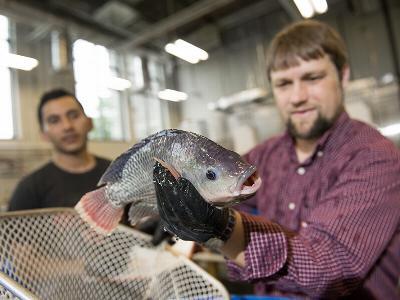U.S. universities collaborate on antibiotic alternative project

SIRF director: Consumer concerns about animal drugs supersede regulatory agencies’ directives
Dr. David Kuhn (right) in his aquaculture lab, College of Agriculture and Life Sciences at Virginia Tech University. Courtesy photo.
A research project that begins next month could provide the aquaculture industry with an innovative tool to combat fish diseases while eschewing the use of antibiotics.
Increasing consumer concerns about the use of veterinary drugs in animal protein production – particularly the antibiotics that health officials deem critical to human health – is what led to the Seafood Industry Research Fund’s (SIRF) interest in finding ways to meet demand for “antibiotic-free” products.
“The trend for consumers is antibiotic-free. We’re seeing that play up strong,” SIRF Chairman Russ Mentzer told the Advocate. “The poultry industry is reacting rapidly and pork is trying to move its products to antibiotic-free. If beef catches on, and finds the same benefits, all proteins with the exception of seafood will be advertised and presented to the consumer as ‘antibiotic-free.’
“We don’t want to compete in that world without an antibiotic-free product and I think restaurant chains want to be able to make that statement about the fish on their menus.”
SIRF is now funding work that may meet this goal. The University of Wisconsin-Madison and Virginia Tech University next month will commence a project titled, “Enhancing Seafood Quality and Safety by Reducing Reliance on Antibiotics; Applying a Novel Antibody in Tilapia.” Mentzer said the two schools’ project is consistent with the strategic plan laid out by the National Fisheries Institute, the leading U.S. seafood industry trade association based in McLean, Va.
Everywhere you look you see the effect of the consumer superseding the effect of the regulatory agencies. The major food manufacturers are listening. You don’t want to be left behind; the financial impact could be disruptive.
Dr. Mark Cook at the University of Wisconsin will develop a tilapia anti-IL-10 peptide antibody. Cook’s previous work has shown that antibiotics can be spared or eliminated in terrestrial animal production using oral antibodies to interleukin-10, an immune cytokine that suppresses immune responses.
The antibodies – produced via chicken egg yolks in a proprietary process – will then be shipped to principle investigator Dr. David Kuhn at Virginia Tech, who will run trials at the school’s aquaculture facilities in Blacksburg, Va. The work, which Kuhn said is “straightforward,” will carry through the remainder of 2016. Kuhn said it is a proof-of-concept study that aims to be the first to show that fish anti-IL-10 can be used in the control of aquatic diseases as a substitute for antibiotics.
The research team will emulsify the antibody into fish oil and apply it as a top coating to commercial fish feed manufactured by Skretting. Once controlled feeding regimens to tilapia are completed, the fish will be exposed to the disease-causing bacterium Aeromonas hydophilia – currently controlled by the use of antibiotics. The results will be compared to a test group of fish on a normal diet to gauge the antibody’s efficacy.
“This is a low-risk experiment. I think it will work,” he told the Advocate. “There’s always the potential pitfall, but I’m optimistic that this kind of research will be successful.”
U.S. regulations make it difficult for domestic producers to use antibiotics, and no prophylactic use is allowed, Kuhn pointed out. But other countries have different requirements, or lax regulations.
“Hopefully this technology will help prevent diseases in fish that are raised in intense conditions,” he said, “and can give U.S. producers an option to do something prophylactically to prevent disease. And if it’s economically viable, it could be used overseas and help protect our seafood supply.”
Mentzer, a former executive at King & Prince Seafood, added that the overarching goal is for a market-based solution that is equal to or better than antibiotics at a cost that’s equal to or lower than antibiotic regimens. He’s concerned that the seafood industry will be late to the party when “antibiotic-free” meats are commonplace in supermarkets.
“Everywhere you look you see the effect of the consumer superseding the effect of the regulatory agencies,” he said. “The major food manufacturers are listening. You don’t want to be left behind; the financial impact could be disruptive.”
The seafood industry has shown to be wary of messaging antibiotic protocols to consumers, as promoting one type of seafood as antibiotic-free may imply that all others are not, which could erode consumer confidence in the entire category. Mentzer said consumers are leading the charge on antibiotics in food.
“There’s certainly going to be a market for ‘antibiotic-free,’” said Mentzer. “How the consumer will react to the labeling remains to be seen. But there’s no stopping the pressure from consumers.”
Related news
 Risk v. hazard: A dispassionate look at pangasius
Risk v. hazard: A dispassionate look at pangasius Wageningen researchers conduct perception-reality analysis of Vietnam’s booming export. The stunning growth of Vietnam’s pangasius industry over the past decade
 Dietary organic acids used as growth promoters, anti-microbials
Dietary organic acids used as growth promoters, anti-microbials The intensification of tilapia culture systems has led to this hardy fish being susceptible to various bacterial diseases causing economic losses to tilapia far
 Aiding gut health with a natural growth promotor
Aiding gut health with a natural growth promotor In Nile tilapia (Oreochromis niloticus) farming – as in all fed aquacultured species – feed accounts for 60 percent of the total production costs.